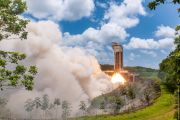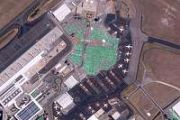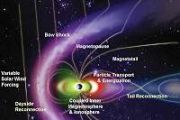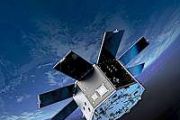
Copernical Team
SpaceX gets OK to build up Starship pads at Canaveral site
Verifying that you are not a bot
What happens to creams and drugs in space? Behavior of soft matter in weightlessness studied
Verifying that you are not a bot
Europe’s next mission to Venus – Envision this (introduction)
 Video:
00:01:01
Video:
00:01:01
Meet Envision. Europe’s next mission to Venus. Planned for launch in 2031.
Envision will study Venus from its core to its upper atmosphere to reveal more about the planet’s history, geological activity, and climate. It will help us understand why Earth’s closest neighbour – in distance as well as in physical characteristics – has evolved into such a hostile planet.
A mission like Envision takes years of planning, involving much teamwork between scientists and engineers. It’s as much a human as a technical endeavour. This video provides a peek behind the scenes at this process.
This short episode is the introduction
Webb observes a dance of dwarf galaxies
 Image:
Webb observes a dance of dwarf galaxies
Image:
Webb observes a dance of dwarf galaxies UAH CanSat and rover teams notch winning performances in 2025 national and international competitions
 UAH students prepare CanSat payload for launch during 2025 International CanSat competition held in Monterey and Staunton, Va.
Three CanSat teams at The University of Alabama in Huntsville (UAH), a part of The University of Alabama System, placed first, second and sixth nationally in the 2025 International CanSat competition held in Monterey and Staunton, Va. UAH teams BlueStreak, Cosmos a
UAH students prepare CanSat payload for launch during 2025 International CanSat competition held in Monterey and Staunton, Va.
Three CanSat teams at The University of Alabama in Huntsville (UAH), a part of The University of Alabama System, placed first, second and sixth nationally in the 2025 International CanSat competition held in Monterey and Staunton, Va. UAH teams BlueStreak, Cosmos a Spire Global faces NYSE noncompliance as contract momentum collides with reporting delay
 On November 25 2025 Spire Global Inc received a notice from the New York Stock Exchange stating that the company is not in compliance with the exchange's continued listing standards because it failed to file its Quarterly Report on Form 10-Q for the quarter ended September 30 2025 on time with the U.S. Securities and Exchange Commission. The NYSE cited Section 802.01E of its Listed Company Manua
On November 25 2025 Spire Global Inc received a notice from the New York Stock Exchange stating that the company is not in compliance with the exchange's continued listing standards because it failed to file its Quarterly Report on Form 10-Q for the quarter ended September 30 2025 on time with the U.S. Securities and Exchange Commission. The NYSE cited Section 802.01E of its Listed Company Manua South Korean team prepares BioCabinet payload for space biology research on Nuri rocket mission
 Chan Hum Park and his research team from Hallym University Chuncheon Sacred Heart Hospital are sending their BioCabinet payload into orbit aboard the fourth Nuri rocket flight on November 27, launching alongside the Next-Generation Medium Satellite-3.
BioCabinet is a research platform featuring a bio 3D printer and an incubator for stem cell differentiation. It will fabricate artificial he
Chan Hum Park and his research team from Hallym University Chuncheon Sacred Heart Hospital are sending their BioCabinet payload into orbit aboard the fourth Nuri rocket flight on November 27, launching alongside the Next-Generation Medium Satellite-3.
BioCabinet is a research platform featuring a bio 3D printer and an incubator for stem cell differentiation. It will fabricate artificial he SatRev PW6U satellite checks in from orbit after Transporter 15 launch
 SatRev reports that its PW6U Earth observation nanosatellite has completed initial commissioning steps after launch on SpaceX's Transporter 15 rideshare mission, with the first link from orbit confirming that power, communications and basic onboard functions are operating as intended.
PW6U is a 6U-class platform built in Wroclaw that extends SatRev's smallsat line into a new generation of
SatRev reports that its PW6U Earth observation nanosatellite has completed initial commissioning steps after launch on SpaceX's Transporter 15 rideshare mission, with the first link from orbit confirming that power, communications and basic onboard functions are operating as intended.
PW6U is a 6U-class platform built in Wroclaw that extends SatRev's smallsat line into a new generation of Mexico to launch its first microsatellite on SpaceX mission
 Mexico's Alvaro Obregon borough plans to send first locally assembled microsatellite into orbit this week on SpaceX's Transporter-15 mission, a rideshare launch scheduled Wednesday from Vandenberg Space Force Base in California.
The launch window is open between 1:18 p.m. EST and 2:15 p.m.
The MXAO-1 Earth-observation satellite was developed through a collaboration between the boroug
Mexico's Alvaro Obregon borough plans to send first locally assembled microsatellite into orbit this week on SpaceX's Transporter-15 mission, a rideshare launch scheduled Wednesday from Vandenberg Space Force Base in California.
The launch window is open between 1:18 p.m. EST and 2:15 p.m.
The MXAO-1 Earth-observation satellite was developed through a collaboration between the boroug Alen Space delivers ETRISat CubeSat to ETRI for upcoming launch on Korean Nuri rocket
 Alen Space has completed and delivered ETRISat, a 6U CubeSat manufactured at its facility in Nigran, Spain, for the Electronics and Telecommunications Research Institute (ETRI) in South Korea. The spacecraft is now in South Korea and will be launched aboard a Nuri (KSLV-II) rocket from the Korea Aerospace Research Institute's Naro Space Center. Launch is scheduled for the coming days.
The
Alen Space has completed and delivered ETRISat, a 6U CubeSat manufactured at its facility in Nigran, Spain, for the Electronics and Telecommunications Research Institute (ETRI) in South Korea. The spacecraft is now in South Korea and will be launched aboard a Nuri (KSLV-II) rocket from the Korea Aerospace Research Institute's Naro Space Center. Launch is scheduled for the coming days.
The 
































